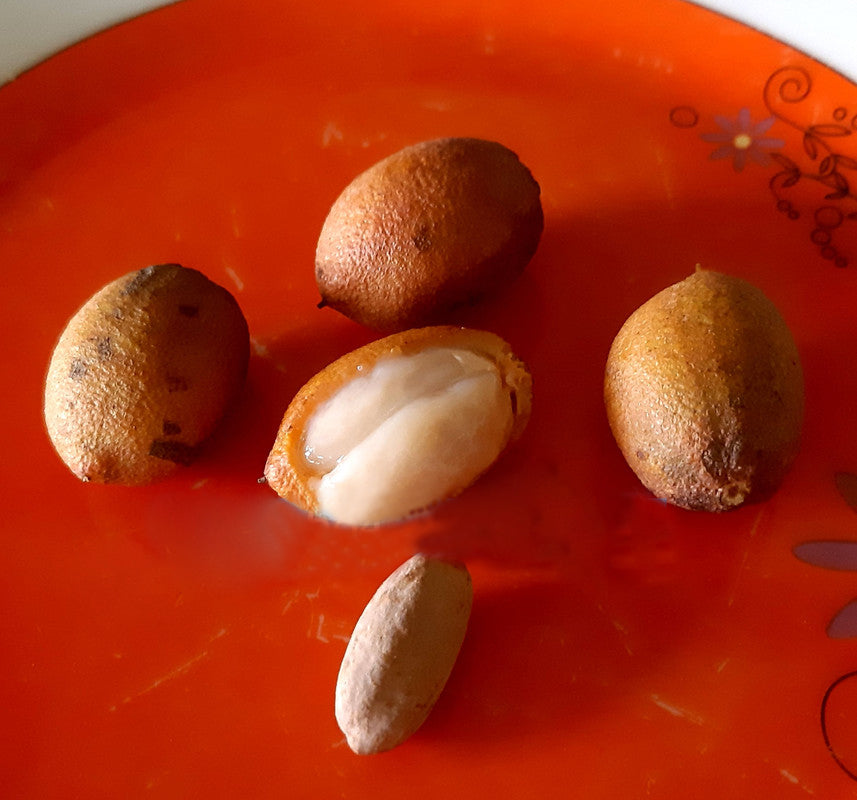Love it? Add to your wishlist
Your favorites, all in one place. Shop quickly and easily with the wishlist feature!
[message]
[title]
[message]


Veliyath Gardens
Couldn't load pickup availability
The Talisia guianensis, commonly known as Wild Pitomba, is a captivating tropical fruit plant native to the Guianas and northern Brazil. This small yet productive shrub thrives in wet tropical biomes, producing fruits that are cherished for their creamy sweetness and nutritional richness. Compact and versatile, it is an excellent choice for home gardens and container planting.
The Wild Pitomba fruit is not only delightful in taste but also offers an array of health benefits, making it a valuable addition to a balanced diet.
Rich in Antioxidants
Packed with vitamin C and polyphenols, it combats free radicals, supports skin health, and reduces inflammation.
Immune System Support
High levels of vitamin C boost immunity, promoting resilience against infections.
Digestive Health
Contains dietary fiber, aiding digestion, preventing constipation, and supporting a healthy gut.
Energy Booster
Natural sugars provide a quick energy source, making it a perfect pre-workout snack.
Improved Cardiovascular Health
Potassium and magnesium help regulate blood pressure and support heart health.
Bone Strength
Traces of calcium and phosphorus contribute to maintaining strong bones and teeth.
The Wild Pitomba’s luscious pulp and sweet flavor make it a versatile ingredient in culinary applications.
Fresh Consumption
The fruit is best enjoyed fresh as a tropical treat, offering a refreshing burst of sweetness.
Desserts
Used in making jams, jellies, and tropical desserts due to its creamy texture and sweet flavor.
Beverages
The pulp can be blended into juices, smoothies, and cocktails for a unique tropical twist.
Candied Fruits
The fruit can be preserved as a candied treat or dried for extended storage.
Culinary Pairings
Complements sweet and savory dishes alike, especially in salads and fruit platters.
Fertilization
Regularly apply organic compost or a balanced fertilizer to promote healthy growth and fruiting.
Pruning
Prune dead or overcrowded branches to improve air circulation and overall plant health.
Pest and Disease Management
Monitor for pests like aphids and scale insects. Natural or organic solutions work best for control.
Container Growth
Ideal for container gardening due to its compact size. Ensure proper drainage and use a potting mix rich in organic matter.
Fresh Storage
Store in a cool, dry place for up to a week. Refrigeration can extend its freshness.
Freezing
Freeze the pulp for long-term storage, ideal for use in desserts and beverages.
Drying
The fruit can be sun-dried or dehydrated, concentrating its flavor and extending shelf life.
In its native range, Talisia guianensis holds cultural and medicinal importance:
The Wild Pitomba (Talisia guianensis) is a treasure from the tropical rainforests, combining exquisite taste with exceptional health benefits. Its versatility, low maintenance, and cultural richness make it a perfect addition to gardens and kitchens alike.
Plant a Wild Pitomba today and savor the delightful fruits while supporting biodiversity and sustainability. Let this tropical gem enrich your life with its sweet flavor, health benefits, and cultural legacy.
Climate: Thrives in wet tropical biomes but can adapt to subtropical regions with proper care.
Sunlight: Prefers full sun to partial shade.
Soil: Requires well-draining, nutrient-rich soil with a pH of 5.5–7.0
Energy Booster
Natural sugars provide a quick energy source, making it a perfect pre-workout snack.
Improved Cardiovascular Health
Potassium and magnesium help regulate blood pressure and support heart health.
Bone Strength
Traces of calcium and phosphorus contribute to maintaining strong bones and teeth.
Traditional Medicine: The fruit and other plant parts are used in folk remedies to treat various ailments, including digestive issues and fatigue.
Cultural Celebrations: Often featured in local festivals and shared among communities as a symbol of abundance.



